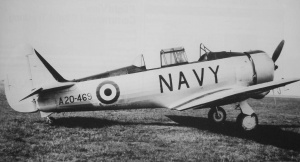
Left & Right: RAN Wirraway training aircraft at the Naval Air Station - Nowra in the early 1950's (Fleet Air Arm Museum).
The Wirraway was a training and general purpose military aircraft manufactured in Australia by the Commonwealth Aircraft Corporation (CAC) during 1939 – 1946 and based on the design of the North American Aviation NA-16 trainer. During the Second World War it was operated by the Royal Australian Air Force as an advanced training aircraft but also saw front line service in New Guinea as a fighter-bomber during 1942 to 1943.
The Wirraway was powered by a single 600 hp Pratt & Whitney R1340 Wasp engine which drove a three bladed variable pitch propeller. Fuel was stored in two 45 gallon tanks. The two-person crew sat within a tandem cockpit, complete with a fully enclosed sliding canopy and both positions were fitted with flying controls. In addition, the rear cockpit featured a rotatable folding seat for the gunner/bomb-aimer, as well as a prone bombing position in the floor of the aircraft. The Wirraway could carry a single 500 lb bomb or two 250 lb bombs under the wings. Lighter weight bombs or flares could also be carried on the underneath centre-line section of the aircraft. Additionally the Wirraway was armed with two forward-firing Vickers Mk V machine guns and a single swivel-mounted machine gun positioned at the rear of the cockpit.
The fuselage was comprised of a welded chrome and steel framework which was constructed from four separately produced sections bolted together during final assembly. The sides of the fuselage featured fabric covering supported by aluminium alloy frames, while the underside and decking had metal coverings. The single spar wings, which were built in five individual sections, were composed of spaced ribs and a stressed skin. The control surfaces were metal-framed with fabric covering. An all-metal stressed skin construction was used for the tailplane and fin.
Seven Wirraways were acquired by the Royal Australian Navy (RAN) as training and general fleet support aircraft between 1948 and 1951 and then an additional ten in 1952 to 1953 which were operated by 723 and 724 Squadrons at the Naval Air Station at Nowra until they were disposed of in 1957. Only one Wirraway was lost during naval service, on 18 June 1953, in a crash at Nowra. The remaining 16 were sold to Lund Aviation Inc. of New York. The De Havilland Vampire subsequently became the new advanced trainer for RAN aircrew.
Specifications
 |
| Type |
Fighter/Training Aircraft |
|---|---|
| Manufacturer |
Commonwealth Aircraft Corporation, Melbourne, Victoria |
| Number Ordered |
755, including 17 for RAN |
| First Delivered |
24 November 1948 |
| Last Delivered |
30 November 1953 |
| Length |
27 feet 10 inches |
| Height |
8 feet 8 inches |
| Weights | 6595 (loaded) |
| Dimensions | Wing span: 43 feet 0 inches |
| Speed | 191 mph |
| Range |
720 miles |
| Crew |
2 |
| Engines | One 600 bhp Pratt & Whitney R-1340 nine cylinder radial |
| Performance |
|
| Armament |
2 x 0.303 Vickers machine guns, 2 x 500 lbs and 2 x 250 lbs bombs |
| Operated by |
RAAF as WW2 fighter/trainer, RAN as trainer at Naval Air Station Nowra |